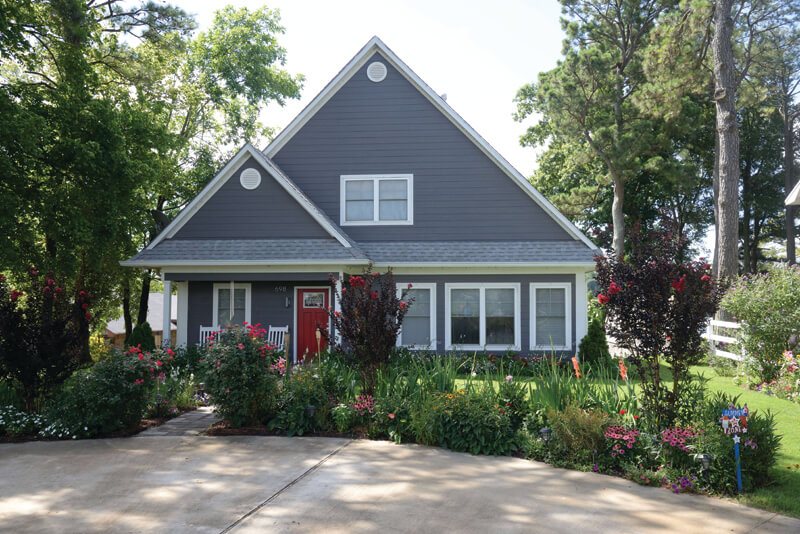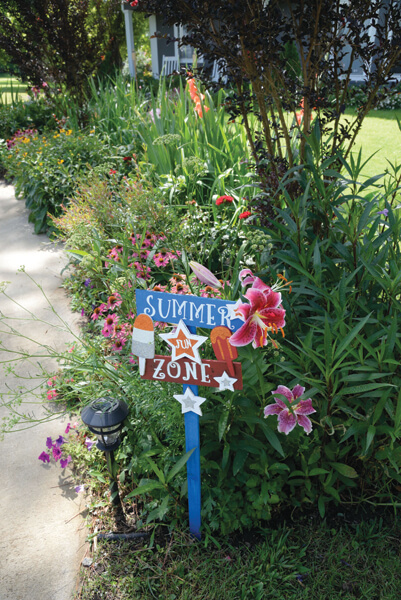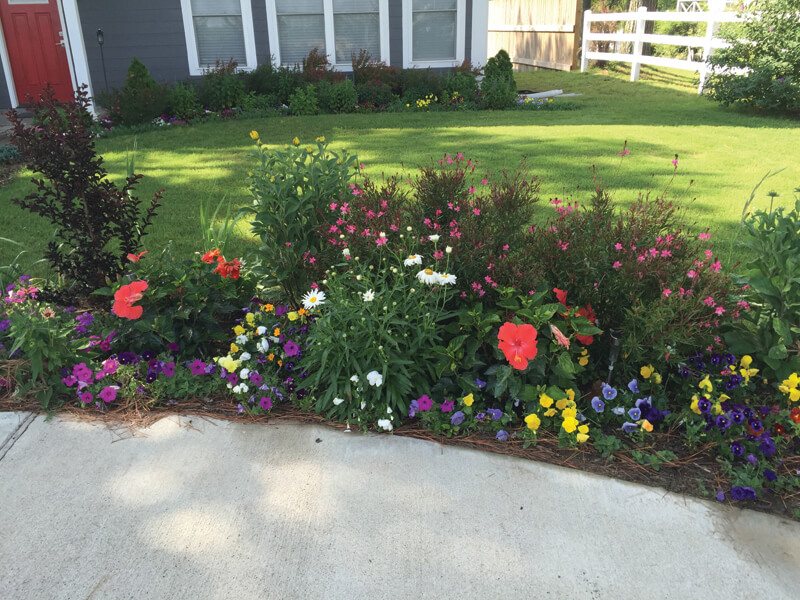PHOTOGRAPHY BY GREG CAMPBELL
Gardening in the Delta is not for the faint of heart. Among the many challenges are insanely hot summer heat, below-freezing temperatures in the winter, defiant soil, too much rain, not enough rain, too sunny, too shady, aggressive weeds, hungry and stinging insects, overly zealous Bermuda grass, plus a whole lot of work to keep everything growing. Not to mention the mosquitos, aphids, and fire ants!
This is why Mark Kennedy is a breath of fresh garden air and is here to share a few tips on how to navigate the trenches. By trial and error, along with a whole lot of experimentation, passion, and hard work, this weekend gardener has built his own version of horticulture heaven in the Mississippi Delta.
Mark lives and works in Memphis during the week, then commutes on the weekends to the Moon Lake home he shares with Scott Thomas. It’s here that Mark and Scott have created their version of beauty, serenity, and production. The beauty is the ample supply of flowers and plants, humming birds, honey bees and butterflies. Serenity arrives with the chirping birds, delicate scents, and the trickling of cascading water from the waterfall on the patio. Production is the fruit, vegetables, and herbs scattered throughout the gardens that bring joy all summer long.
Mark does all of the gardening at the house, and faces the same challenges that most of us do, having only the weekends to work in the gardens—and with fourteen gardens that can be a daunting task.
“If I can do it, anyone can,” Mark says happily.
His list for success is a mile long and six years deep, but it all starts with three simple rules.
“If you build your beds correctly, do your homework, and then make a plan, gardening can really be relaxing, therapeutic and enjoyable,” Mark adds “And gardening should be fun and not a chore, right?”
Make Your Bed
“If you do it right in the beginning, your life will be magical and you will be rewarded with bountiful gardens that you will enjoy for years to come.”
Pearls of wisdom coming from someone, who like most of us, tried it the hard way.
“Prior to building the lake house, I, like many of us, just went to the garden center, picked out the flowers that I liked, and expected them to grow with a little watering here and there,” Mark says. “Trust me, in the South it doesn’t work that way. I never really looked at the little sticks or gave any thought as to how the end result would look like or paid much attention to the dirt, or where the sun came up and set. These are all so important when starting out.”
Mark changed his ways when they built the lake house, mapping out exactly what they wanted before a plant was ever bought and that meant first making sure any clay was gone and adding sand, garden soil, manure (Black Kow found at Lowe’s) to the beds and tilling it all together.
“Watch this,” Mark says, as he plunges his hand five inches deep into the rich fertile soil of his front flower bed that hasn’t had anything added to it since last fall. “The key to great gardens is all about the ground and starting your beds off right, just like you would do with your child on their first day of school. Do that and you will actually have fun in your gardens.
So let’s review.
The worst thing that frustrates a new gardener is not seeing the fruits of their labor, so what is his secret?
“Nothing is going to grow in clay,” he answers, so when preparing your beds, you want to till at least a foot deep and remove as much clay as you can. Once you have removed the clay, fill back in with a third of sand, a third of garden soil, and a third of cow manure and work it all in together.
While this may be a little bit of an investment, the rewards will far outweigh the initial cost, and you won’t ever have to worry about them again. In the fall you will add a layer of raked fallen leaves to your bed and a light dusting of mulch. This breaks down through the winter and adds richness to the soil. In spring each year, add a light dusting of Black Kow manure, and that is all it takes.
“Year after year, the beds will get deeper and richer—to the point you will hardly need a garden tool,” Mark promises. “Now that is what I call fun.”
Side note: Mark says that if you have established gardens you don’t want to till up, you can add sand and manure around the plants. It takes a bit longer, but it will improve your soil dramatically.
Do your Homework
“If you just go out and buy lots of pretty plants without a plan, you are setting yourself up for frustration and possible failure,” Mark notes.
That’s why, he underlines, it is so important to do your groundwork and homework ahead of time. Before you buy one single plant after your flower beds are ready, write down on a note pad where the sun comes up and where it sets, noting exactly how much sun each section of your house gets. This is key to happy, thriving, bountiful plants. Also, take into consideration shade trees and how much shade they cast throughout your garden during the day, as this also plays in to your overall garden health.
Consider how much you want to spend and how many gardens you want. Mark suggests the new gardener start with one or two and do those right—as opposed to a bunch. Flowers and plants can get costly and quickly frustrate a new gardener. Start slowly.
There’s no doubt about it: Delta summers are harsh. Plants that start off colorful and healthy in April can become victims in August of a Darwinian garden experiment gone wrong.
“Each garden should have a story, to which you want to add a cast of characters that complement the story,” Mark says. “It is very important to know what plants like to hang out with one another.”
An example would be shade versus sun. Hydrangeas, hostas, and impatiens are shade-loving plants that love to be watered daily, as opposed to Knock Out roses that want full sun and only want to be watered once every three to four days or so.
Seek counsel from an experienced gardener or a reputable garden store. Mark purchases all of his plants in Memphis from Dan West Garden Center and Lowe’s Garden center off Perkins. The manager at Lowe’s worked closely for many years with the former curator of the butterfly garden at the Memphis zoo. These two ladies really helped Mark take his butterfly gardens to a new level. Kenneth Mabry and the staff at Dan West Garden have been in business for as long as Mark can remember, which is well over thirty years. Both places have large varieties of plants and flowers and are the very knowledgeable.
Mark advises to always consult with someone when you visit a garden center and to be patient and deliberate when mapping out your plan.
He also suggests taking a day to go to one of these centers when you have plenty of time, and learn first from these mentors before buying a single plant. Take notes, look and look and look, and learn what plants like to be together. Then go home and fill out the details of your plan. Once your plan is set, you will then know exactly what you need and buying will be a breeze.
Make A Plan
There is a purpose for every garden: feeding the soul and taking in nature. Harvesting fresh fruits and vegetables, enjoying pops of brilliant color outside, plucking stems to put in vases, keeping up with the Joneses, impressing the garden club, or simply doing just enough from being deemed a barren land.
“Think about what excites you, what relaxes you, what works good for you,” Mark advises. Make a solid plan/goal before you start to plant your garden.
This goal/plan steers the process on your path to success, from plant buying to planting to long-term maintenance. Remember, Mark emphasizes it is okay for your PLAN to be just that—YOUR PLAN. Do what makes you happy and fits your tastes and budget and the rewards will be that much sweeter.
“Our gardens are all about bringing nature in,” Mark says about his objective. “Everything here is designed to be a songbird, butterfly, hummingbird, honey bee sanctuary. Our gardens are helping the environment, plus the bees and butterflies help pollinate everything around them.”
Mark used to take the symmetrical approach to his gardens. But now he mixes it up with flowers, vegetables, herbs, fruit trees, and berries. All of the above grow next to each other in various stages throughout the gardens. Doing this, Mark explains, has eliminated the need for insecticide.
“Again, it’s all about preserving nature with our gardens,” he says. “We want it to be as inviting and as natural as possible.”
Sometimes—especially when time and funds are limited—the ideal garden plan may seem out of reach; Mark understands this. His gardens have been a work in progress now for six years. He, like many of us, works full time and is on a budget, too.
“You don’t have to do it all at once,” Mark reminds. “Start slow and do one garden right” he suggests. Once you have one garden right with the things you love, then you will be more inclined to add to them year after year. Before you know it, you will be hooked.”
And it’s that reward that Mark finds pleasing about his garden, and six years into it, they are now up to fourteen gardens.
“With all that is going on in the world right now, to be able to come down to the lake house and take a walk around the property and see something new growing excites me,” Mark says happily. “There is nothing better than picking a cherry tomato right off the vine and eating it.
“The sounds of the birds, the waterfall, the sweet smell of the flowers, the buzzing of the honey bees, and butterflies fluttering around making me feel like the luckiest guy in the world. All of this, overlooking Moon Lake and we are able to share it with all of our friends and family and Moon Lake family. Life doesn’t get much sweeter than that.”










